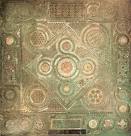Grainy black-and-white footage of Elizabeth II’s coronation shows the young queen enthroned, amid the panoply of state, before the altar of Westminster Abbey. But a key element of the ceremony, which has been carried out in the same place and according to the same traditions since the thirteenth century, was hidden from view by a large expanse of monochrome institutional carpeting. Beneath that carpet, neglected but not quite forgotten, lay one of the masterpieces of the Middle Ages – a spectacular Cosmati-work floor, designed in an intricate pattern of interlocking spheres and squares, formed from a mosaic of over 80,000 separate pieces of stone.
The great Cosmati pavement had been an integral part of the coronation ceremony since the time of Henry III, when it was created to evoke the harmony of the spheres and the perfection of heaven. Its rich symbolism was still understood in the age of Henry VIII, when Holbein placed his melancholy Ambassadors, who dream of salvation in the world to come, on a Cosmati-work floor just like the one in Westminster Abbey – and in the age of Elizabeth I, when Shakespeare wrote that “the floor of heaven / Is thick inlaid with patterns of bright gold: / There’s not the smallest orb which thou behold’st / But in his motions like an angel sings...”
But by the end of the nineteenth century, the brilliant inlaid floor had been covered over. Only now can it be seen, once more, in all its magnificence. Thanks to a vigorous fundraising campaign, the Abbey has been carrying out long overdue repairs to its delicate fabric. Throughout this summer, work will continue to clean and fix the pavement’s many thousands of mosaic tiles. The restoration is being carried out in open view, so anyone who wants can witness the...


